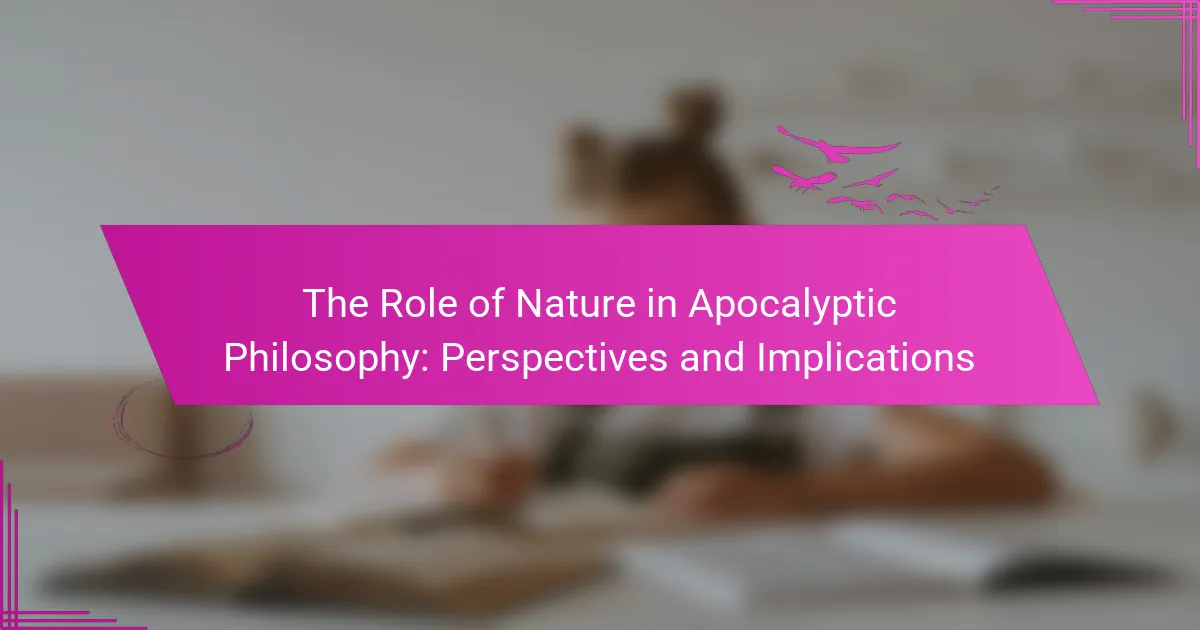Nature plays a crucial role in shaping apocalyptic philosophy, influencing ethical responsibilities and societal reflections. This article explores how different cultures interpret nature’s dual role as both a destructive force and a source of renewal. It examines the transformative characteristics of natural disasters, the implications of ecological crises, and the emerging narratives that highlight humanity’s connection to the environment. Understanding these perspectives fosters a reevaluation of values and promotes sustainable practices in the face of existential threats.

How does nature influence apocalyptic philosophy?
Nature significantly shapes apocalyptic philosophy by providing a backdrop for existential reflection and moral contemplation. Natural disasters often symbolize divine wrath or the consequences of human actions. Philosophers like Martin Heidegger and Emmanuel Levinas emphasize humanity’s connection to nature, suggesting that ecological collapse can provoke a reevaluation of ethical responsibilities. Furthermore, the imagery of nature in apocalyptic narratives serves as a powerful reminder of vulnerability and transience. This interplay between nature and philosophy prompts discussions about sustainability, human agency, and the future of life on Earth.
What are the core principles of apocalyptic philosophy?
Apocalyptic philosophy emphasizes the transformative role of nature as a catalyst for change and reflection. Nature often symbolizes both destruction and renewal, showcasing humanity’s relationship with the environment. Various perspectives highlight that natural disasters can serve as warnings, urging people to reconsider their actions. Additionally, nature’s cycles reflect themes of life, death, and rebirth, reinforcing the idea that endings can lead to new beginnings. This duality shapes the implications of apocalyptic thought, suggesting a need for harmony between humanity and the natural world.
In what ways does nature serve as a symbol in apocalyptic narratives?
Nature symbolizes destruction, renewal, and humanity’s relationship with the environment in apocalyptic narratives. It often reflects the consequences of human actions, illustrating themes of environmental degradation and climate change. For example, desolate landscapes signify the end of civilization, while natural disasters represent the wrath of nature. Conversely, nature can also symbolize hope, suggesting potential regeneration and rebirth after catastrophe. This duality emphasizes the interconnectedness between humanity and the natural world, highlighting the moral implications of ecological responsibility.
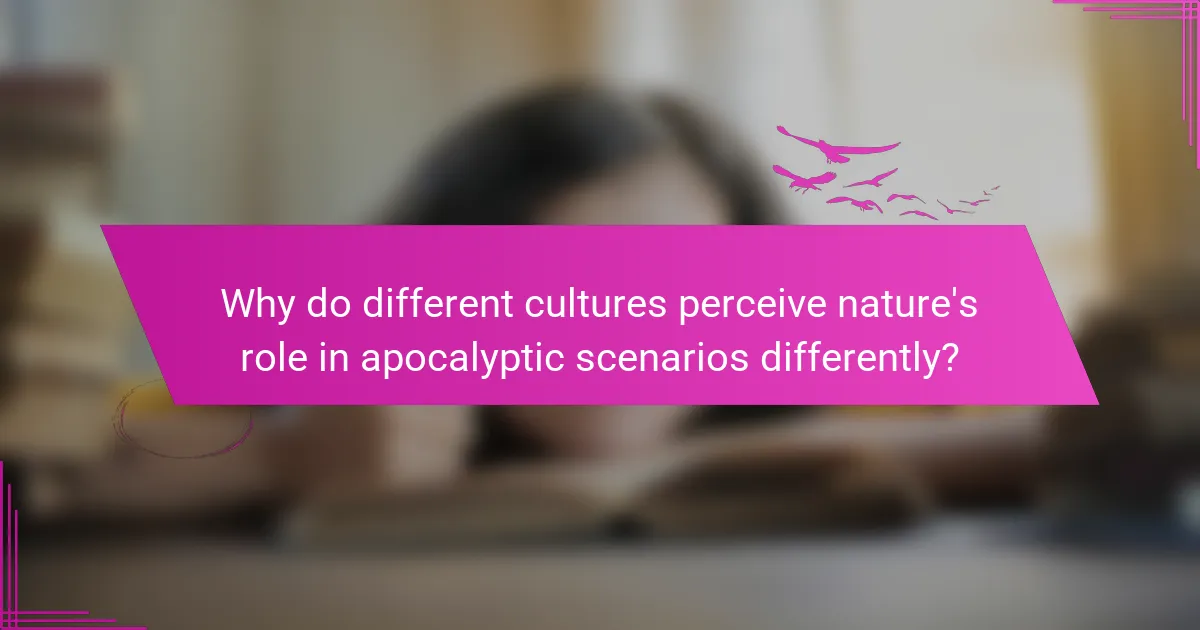
Why do different cultures perceive nature’s role in apocalyptic scenarios differently?
Different cultures perceive nature’s role in apocalyptic scenarios based on their historical, spiritual, and environmental contexts. For example, in some cultures, nature is viewed as a destructive force that punishes humanity, while in others, it represents renewal and rebirth. This duality reflects unique attributes in cultural narratives, shaping beliefs about humanity’s relationship with the environment. Additionally, rare interpretations may emerge from specific ecological experiences, influencing how societies envision apocalyptic futures. Understanding these perspectives highlights the complex interplay between cultural identity and environmental philosophy.
How does Western thought interpret nature in the context of apocalypse?
Western thought often interprets nature as a reflection of human moral and existential crises during apocalyptic scenarios. Nature embodies both destruction and renewal, serving as a backdrop for human actions and consequences.
Philosophers like Martin Heidegger argue that nature reveals humanity’s relationship with existence and technology. In apocalyptic narratives, nature often symbolizes the consequences of human neglect, illustrating themes of loss and regeneration.
Additionally, apocalyptic literature frequently depicts nature responding to human transgressions, emphasizing a moral order. This perspective reinforces the idea that humanity must realign with nature to avert catastrophe.
Ultimately, the interpretation of nature in apocalyptic philosophy underscores a complex interplay between human agency, ethical considerations, and the natural world, urging reflection on our impact on the environment.
What are the perspectives on nature in Eastern apocalyptic traditions?
Eastern apocalyptic traditions often view nature as a vital force intertwined with human existence. Nature is seen as both a reflection of cosmic order and a harbinger of change.
In many Eastern philosophies, natural events symbolize moral and spiritual lessons. For example, earthquakes or floods represent the disruption of harmony, prompting introspection and a return to balance. This perspective emphasizes interconnectedness, suggesting that humanity’s fate is linked to the health of the environment.
Additionally, some traditions envision nature as a site for renewal. The cyclical patterns of seasons illustrate rebirth and transformation, reinforcing the belief that destruction can lead to new beginnings. This duality in nature’s role highlights a unique attribute of Eastern apocalyptic thought: the potential for regeneration amidst chaos.
Overall, nature in Eastern apocalyptic traditions embodies both warning and hope, illustrating the profound implications of ecological awareness and spiritual growth.
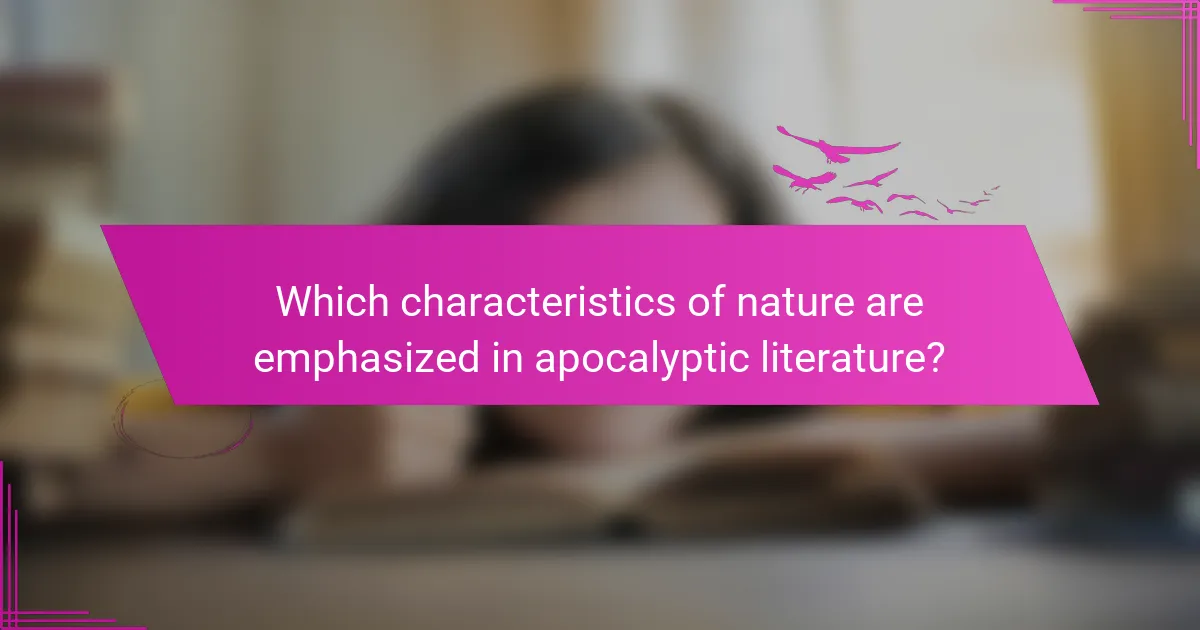
Which characteristics of nature are emphasized in apocalyptic literature?
Apocalyptic literature emphasizes nature’s transformative and destructive characteristics. It often portrays natural disasters as manifestations of divine judgment, reflecting humanity’s moral failings. Common elements include catastrophic events like floods, earthquakes, and plagues that signal impending doom. These depictions serve to illustrate the fragility of human existence against nature’s overwhelming power. Additionally, nature’s renewal is a recurring theme, symbolizing hope and rebirth after destruction.
What role does the concept of destruction play in nature-related apocalyptic themes?
Destruction in nature often symbolizes renewal and transformation in apocalyptic themes. It reflects humanity’s relationship with the environment and highlights the fragility of ecosystems. Nature’s destructive forces serve as a reminder of the consequences of human actions. This duality emphasizes the need for sustainable practices to prevent catastrophic outcomes. Such themes provoke reflection on our responsibilities toward the planet and encourage a reevaluation of our impact on the world.
How is regeneration depicted in relation to nature in apocalyptic texts?
Regeneration in apocalyptic texts often symbolizes nature’s resilience and renewal. These narratives depict nature as a force that withstands destruction, embodying hope and rebirth. For instance, many texts illustrate how ecosystems recover after cataclysmic events, emphasizing the cyclical patterns of life. This perspective highlights nature’s unique ability to regenerate, serving as a metaphor for human endurance and the possibility of a fresh start.
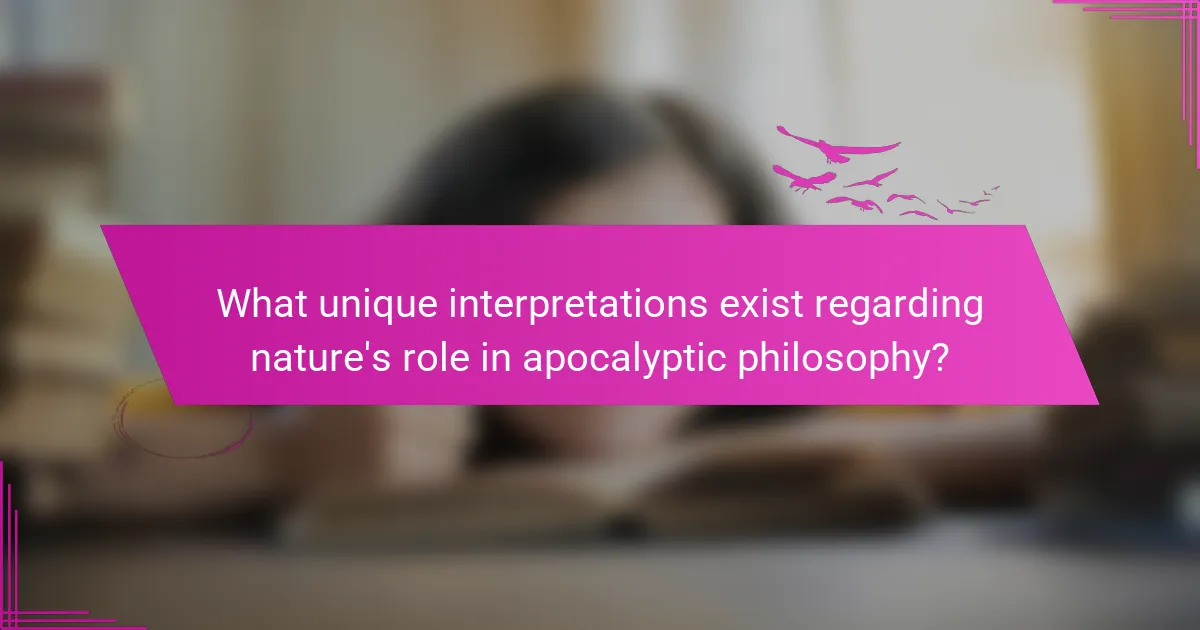
What unique interpretations exist regarding nature’s role in apocalyptic philosophy?
Nature plays a multifaceted role in apocalyptic philosophy, often interpreted as both a harbinger of destruction and a source of renewal. Some perspectives emphasize the idea that natural disasters symbolize humanity’s failure to live in harmony with the environment. This view suggests that ecological collapse is a direct consequence of moral and ethical failings.
Conversely, other interpretations highlight nature as a restorative force, positing that apocalyptic events can lead to a rebirth of ecosystems and societies. This perspective suggests that destruction may pave the way for new beginnings, emphasizing resilience and regeneration.
Additionally, rare interpretations consider nature as a moral agent, suggesting that it communicates warnings to humanity. This view reflects a belief that nature’s changes serve as a guide for ethical living.
Overall, these unique interpretations illuminate the complex relationship between nature and humanity in the context of apocalyptic thought, showcasing nature’s dual role as both a destroyer and a healer.
How do indigenous beliefs shape the understanding of nature in apocalyptic contexts?
Indigenous beliefs profoundly influence the understanding of nature in apocalyptic contexts by emphasizing interconnectedness. Many indigenous cultures view nature as a living entity, integral to their cosmologies. This perspective fosters a sense of responsibility towards the environment, particularly in times of crisis.
Apocalyptic narratives often reflect a deep respect for natural cycles and warn against environmental degradation. For instance, some indigenous prophecies highlight the consequences of disrupting ecological balance, framing environmental collapse as a sign of impending doom.
Furthermore, indigenous practices, such as land stewardship and sustainable resource management, embody a unique attribute of their worldview. These practices serve as a counter-narrative to dominant industrial paradigms, advocating for harmony with nature.
In summary, indigenous beliefs shape apocalyptic understanding by framing nature as a vital partner in existence, urging collective action to prevent ecological catastrophe.
What are the implications of climate change on apocalyptic thought?
Climate change significantly influences apocalyptic thought by intensifying fears of environmental collapse. As natural disasters increase, these events reshape philosophical perspectives on humanity’s future.
The implications include a heightened sense of urgency regarding ecological preservation. This urgency can lead to existential reflections on human responsibility and the interconnectedness of life.
Moreover, climate change often serves as a catalyst for apocalyptic narratives in literature and media, reinforcing a collective anxiety about potential societal breakdown. These narratives can inspire both despair and hope, prompting discussions about sustainable solutions.
In summary, climate change not only alters physical landscapes but also profoundly impacts philosophical and cultural interpretations of apocalypse, encouraging a reevaluation of humanity’s role in nature.
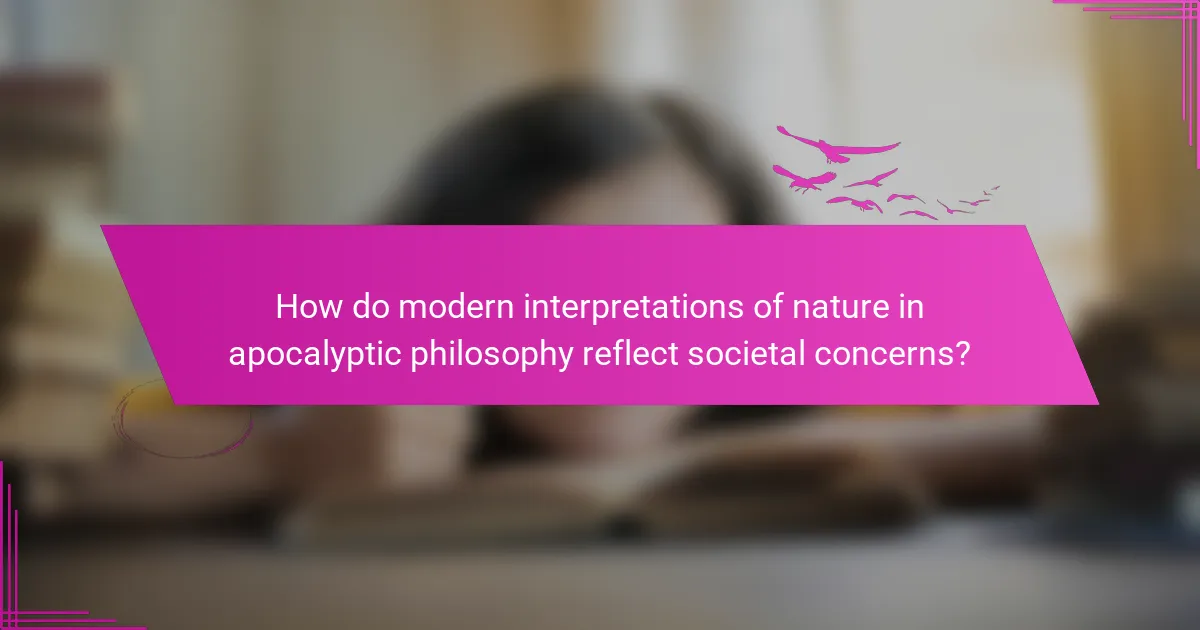
How do modern interpretations of nature in apocalyptic philosophy reflect societal concerns?
Modern interpretations of nature in apocalyptic philosophy reflect societal concerns about ecological crises and existential threats. These interpretations often depict nature as both a victim and a catalyst of human actions. As climate change intensifies, narratives emphasize humanity’s disconnection from nature, highlighting the urgency for environmental stewardship.
Philosophers argue that these interpretations serve as a mirror for societal anxieties, revealing fears about sustainability and the future. For instance, the portrayal of nature’s wrath in apocalyptic scenarios underscores the consequences of environmental neglect. This reflects a unique attribute of contemporary thought, where nature is seen as an active participant in shaping human destiny.
Furthermore, apocalyptic narratives often invoke rare attributes like the idea of nature reclaiming urban spaces, symbolizing hope amidst despair. These themes resonate with audiences, prompting discussions about responsibility and resilience. As a result, modern apocalyptic philosophy not only critiques societal behaviors but also inspires action towards a more harmonious relationship with the environment.
What are the common themes found in contemporary apocalyptic literature?
Contemporary apocalyptic literature frequently explores themes of nature’s power and fragility. Nature often serves as a mirror reflecting human actions and societal collapse. The narratives emphasize environmental degradation, climate change, and the consequences of neglecting ecological balance. These themes highlight humanity’s interconnectedness with nature and the implications of its destruction. The portrayal of nature can evoke both fear and hope, suggesting potential regeneration or irreversible loss.
How do visual arts portray nature in apocalyptic scenarios?
Visual arts depict nature in apocalyptic scenarios as a symbol of both destruction and resilience. Artists often illustrate landscapes ravaged by environmental collapse, emphasizing the fragility of ecosystems. This portrayal reflects philosophical perspectives on humanity’s relationship with nature and the consequences of neglecting it. Nature, in these artworks, serves as a reminder of lost beauty and a call to action for environmental stewardship. The imagery evokes emotional responses, prompting viewers to consider the implications of their actions on the planet’s future.
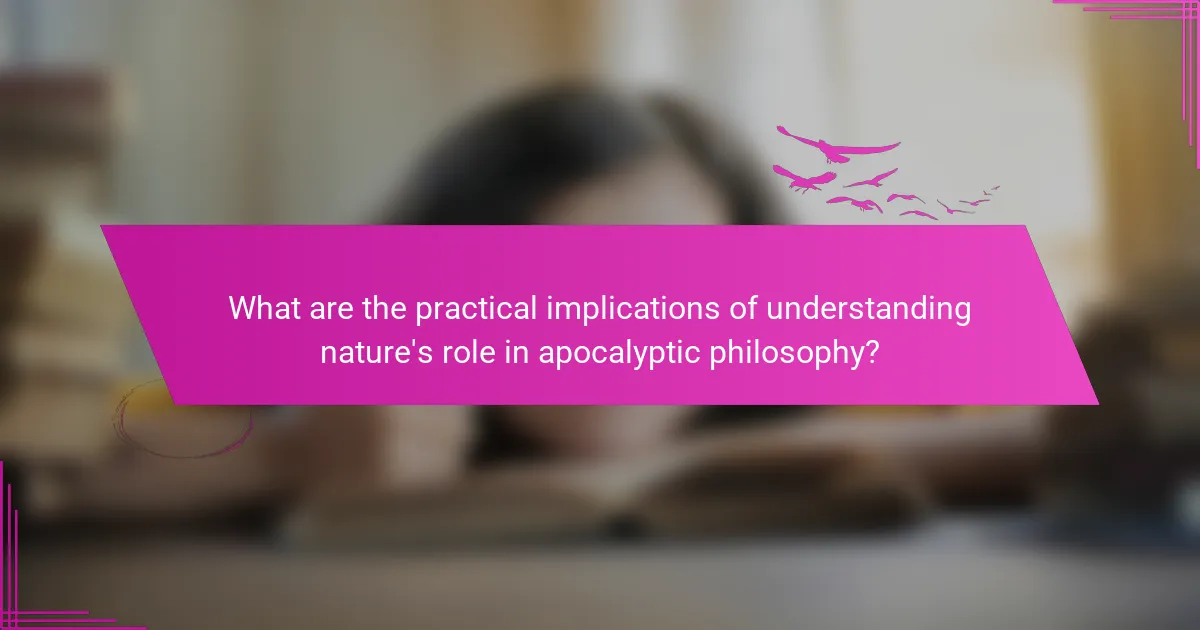
What are the practical implications of understanding nature’s role in apocalyptic philosophy?
Understanding nature’s role in apocalyptic philosophy reveals practical implications for environmental ethics and societal resilience. It emphasizes the interconnectedness of humanity and the natural world, prompting a reevaluation of values and priorities. Recognizing ecological limits fosters sustainable practices, influencing policy and individual behavior. This perspective encourages proactive engagement with environmental challenges, ultimately shaping a more harmonious relationship with nature.
What strategies can be employed to address environmental issues through the lens of apocalyptic philosophy?
Employing strategies rooted in apocalyptic philosophy can effectively address environmental issues. These strategies often emphasize the interconnectedness of humanity and nature, advocating for a transformative perspective on ecological responsibility.
One approach is adopting a narrative that frames environmental degradation as a precursor to a necessary societal awakening. This perspective encourages proactive measures to restore balance with nature. Additionally, engaging in community-building initiatives fosters resilience and collective action, emphasizing shared responsibility for the environment.
Another strategy involves integrating environmental ethics into education, promoting awareness of the consequences of neglecting nature. This can lead to a cultural shift that prioritizes sustainability and conservation. Lastly, utilizing art and literature to explore apocalyptic themes can inspire individuals to reflect on their relationship with the natural world, motivating change.
What common misconceptions exist about nature in apocalyptic thought?
Common misconceptions about nature in apocalyptic thought include the belief that nature is solely destructive and that it lacks resilience. Many view nature as a passive victim of human actions, ignoring its capacity for regeneration. Additionally, there is a misconception that apocalyptic scenarios only focus on environmental collapse, disregarding the potential for harmony and coexistence in these narratives. Such views can lead to a nihilistic perspective, overlooking the transformative power of nature in response to crises.
